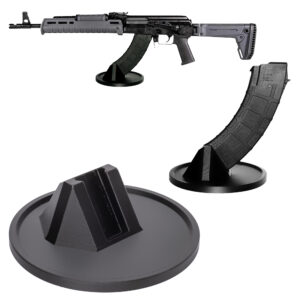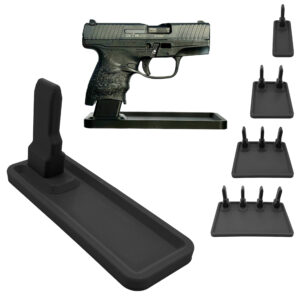Categories:
The AK-47 and its modern variant, the AKM, are two of the most iconic assault rifles in military history, each playing a pivotal role in shaping contemporary warfare. Developed in the Soviet Union during the aftermath of World War II, the AK-47 was designed by Mikhail Kalashnikov and officially adopted by the Soviet Army in 1949. Renowned for its reliability, ease of use, and effectiveness in various combat conditions, it quickly became a symbol of revolutionary movements worldwide.
The original design featured a milled receiver and wood furniture, contributing to its durability but also adding weight.
In response to evolving military needs and advancements in guns technology, the AKM was introduced in 1959 as an updated version of the classic AK-47. The redesign focused on reducing weight while maintaining performance standards. By utilizing a stamped steel receiver rather than a milled one, along with lighter materials for components such as furniture and magazine design, the AKM achieved significant improvements in portability without sacrificing reliability—an essential characteristic that both rifles share.
While both weapons fire the same 7.62x39mm cartridge and share many operational features—including their gas-operated mechanism—the differences between them extend beyond mere aesthetics or construction methods. The evolution from the AK-47 to the AKM reflects broader trends within military technology: an emphasis on adaptability for diverse combat environments while still honoring traditional principles of gun design that prioritize functionality over complexity.
Understanding how these two rifles compare requires examining their performance metrics—such as accuracy, rate of fire, recoil management—and considering how advancements like improved materials influence their operational effectiveness on modern battlefields. In exploring these aspects further, we can appreciate not only their historical significance but also their enduring legacy within global conflicts today.
The AK-47, developed in the late 1940s by Mikhail Kalashnikov, emerged from the need for a reliable and effective infantry weapon suitable for the Soviet Union’s post-World War II military doctrine. The design was characterized by its simplicity, durability, and ease of use, making it an ideal choice for soldiers across various environments. Its initial production began in 1949, and the rifle quickly gained notoriety for its high rate of fire and ability to function under adverse conditions.
The AK-47 utilized a 7.62x39mm cartridge, which provided a balance between stopping power and manageable recoil.
As military technology evolved during the mid-20th century, so too did interest in refining existing weapon systems. In response to operational feedback and advancements in materials and manufacturing processes, the AKM (Avtomat Kalashnikova Modernizirovanniy) was introduced in 1959 as an updated version of the original AK-47 design. The AKM featured several significant improvements over its predecessor: it was lighter due to the use of stamped metal components instead of milled parts, enhancing both portability and production efficiency.
Moreover, while retaining many core aspects of the AK-47’s functionality—such as reliability and ease of maintenance—the AKM offered enhanced accuracy through modifications to its barrel and sighting systems. The introduction of a lighter cartridge variant further contributed to improved performance metrics on the battlefield.
Throughout their histories, both rifles have been widely adopted by numerous countries around the world due to their effectiveness in combat situations. While they share foundational characteristics that define Kalashnikov’s legacy, distinct differences in their construction reveal an evolution driven by necessity—a reflection of changing warfare dynamics during the Cold War era. This historical context helps frame an understanding of how each rifle serves different tactical needs even today.
The design differences between the AK-47 and the AKM are pivotal in understanding their performance characteristics and operational suitability. While both rifles share a common lineage, the AKM was developed as an improvement over the original AK-47 design, addressing various limitations identified during its use.
One of the most significant changes in the AKM is its construction. The original AK-47 features a milled receiver, which adds to its robustness but also increases weight. In contrast, the AKM employs a stamped steel receiver that not only reduces weight significantly but also streamlines manufacturing processes. This shift enhances portability and allows for easier mass production without compromising reliability.
Another notable modification is found in the barrel design. The AKM has a lighter, thinner barrel compared to that of the AK-47, which contributes to reduced overall weight while maintaining acceptable accuracy standards. The muzzle brake on the AKM has also been redesigned to mitigate recoil more effectively than that of its predecessor, allowing for improved control during rapid fire.
The sights have seen enhancements as well; while both rifles utilize iron sights, the adjustments on the AKM are more refined and user-friendly. This refinement aids shooters in making quick sight adjustments under varying combat conditions.
In terms of internal components, improvements have been made in materials and engineering tolerances within the gas system and bolt carrier group of the AKM. These upgrades result in better cycling reliability under adverse conditions—an essential feature for military applications where environmental factors can be unpredictable.
Overall, while both rifles embody ruggedness and reliability synonymous with Kalashnikov designs, these key differences enhance performance metrics such as weight management, recoil control, and operational flexibility—making the AKM a more versatile choice for modern combat scenarios compared to its predecessor.
When comparing the AK-47 and the AKM, one of the most significant aspects to consider is their ballistics and caliber performance. Both rifles are chambered for the 7.62x39mm cartridge, which is known for its effective range and stopping power. However, there are nuances in their design that influence how each rifle performs with this caliber.
The original AK-47 was designed in the late 1940s and features a heavier construction with a milled receiver. This contributes to its durability but also adds weight, which can affect handling during rapid fire or extended use. The AKM, introduced in the 1950s as a modernization of the original design, utilizes a stamped receiver that reduces weight while maintaining structural integrity.
This change not only enhances maneuverability but also allows for quicker target acquisition due to its lighter build.
In terms of ballistics, both rifles deliver similar muzzle velocities—typically around 700 to 730 meters per second—due to their shared cartridge. However, the AKM’s improvements in gas operation lead to slightly better recoil management and overall accuracy during sustained fire. The lighter construction enables more controllable follow-up shots without sacrificing terminal ballistics.
Moreover, while both rifles maintain comparable effective ranges of about 300 to 400 meters for point targets, shooters often report that the AKM’s refinements lead to improved performance at these distances. The combination of reduced weight and better recoil control allows marksmen using an AKM to engage targets more effectively than those wielding an older AK-47 model.
Ultimately, while both guns share a common lineage and caliber, the advancements seen in the AKM provide it with distinct advantages in terms of handling characteristics and overall shooting experience without compromising on ballistic effectiveness.
When comparing the accuracy and range of the AK-47 and its modernized counterpart, the AKM, it is essential to understand the design improvements that have been made over time. Both rifles share a similar fundamental design, but the AKM was developed to enhance performance in several key areas, including accuracy and effective range.
The original AK-47, introduced in 1949, was designed primarily for reliability and ease of use in various combat conditions. Its 7.62x39mm cartridge delivers substantial stopping power at close to medium ranges. However, due to its heavier construction and older manufacturing techniques, it tends to exhibit greater recoil during rapid fire. This recoil can affect shooting precision when firing multiple rounds in quick succession, leading to a less consistent accuracy at longer distances.
In contrast, the AKM—introduced in 1959—features several refinements that improve both handling and performance. The most significant changes include a lighter receiver made from stamped steel rather than milled components and an improved muzzle brake that helps mitigate recoil. These modifications contribute to enhanced stability during shooting sessions. As a result, shooters often find they can maintain better control over their shots even when engaging targets rapidly.
The effective range of both rifles is typically around 300 meters for point targets; however, the AKM’s design allows for slightly better accuracy at these distances due to reduced muzzle rise during automatic fire. Additionally, while both weapons are capable of reaching out effectively beyond their standard operational ranges—upwards of 400 meters—the increased consistency provided by the AKM’s enhancements allows marksmen to achieve more precise hits.
In summary, while both rifles serve as reliable platforms within their intended roles, the AKM’s advancements make it superior regarding accuracy and range performance compared to its predecessor—the iconic AK-47.
When comparing the AK-47 and the AKM, one of the most significant factors is their durability and reliability in various conditions. Both guns are renowned for their resilience, yet subtle differences stem from their design evolution that impact performance in challenging environments.
The original AK-47, designed by Mikhail Kalashnikov in the late 1940s, was built with a heavier receiver made from milled steel. This construction offers exceptional durability, allowing the weapon to withstand harsh conditions such as extreme cold or excessive heat without compromising its functionality. The milled receiver also tends to be more resistant to warping and damage from impacts compared to stamped receivers.
However, this robustness comes at a cost; the weight of the AK-47 can hinder maneuverability and ease of use over prolonged periods.
In contrast, the AKM—an updated version introduced in 1959—features a lighter stamped receiver made from sheet metal. While this design reduces overall weight significantly (approximately 2 pounds lighter than its predecessor), it does not compromise on reliability. The stamping process allows for mass production while maintaining structural integrity under stress. The AKM’s construction enables it to perform exceptionally well in adverse conditions such as mud, sand, or waterlogged environments where debris can easily jam less rugged guns.
Both rifles share an essential feature: they are engineered for easy maintenance and field-stripping capabilities. This ensures that soldiers can quickly clean and repair their weapons under fire or during extended operations away from support facilities. Ultimately, both models demonstrate remarkable reliability across diverse terrains; however, users may prefer one over the other depending on specific operational needs—whether prioritizing maximum durability or reduced weight without sacrificing performance.
In evaluating the performance of the AK-47 and its successor, the AKM, several key factors emerge that highlight both similarities and differences in their operational capabilities. The AK-47, introduced in 1949, is renowned for its rugged reliability and simplicity. It was designed for mass production under austere conditions and has been used in various conflicts worldwide. However, as warfare evolved, so too did the need for improved weaponry that could address emerging tactical demands.
The AKM, developed in the late 1950s as an upgrade to the original AK-47 design, incorporates significant advancements that enhance its overall performance. One of the most notable improvements is its weight reduction; by utilizing a lighter receiver and a wooden stock with a more streamlined design, the AKM offers greater maneuverability without sacrificing durability. This makes it particularly advantageous in close-quarters combat where agility is paramount.
Furthermore, while both rifles share similar calibers (.762x39mm) and basic operating principles—gas-operated action with rotating bolt—the AKM features enhancements such as a modified muzzle brake that reduces recoil and improves accuracy during rapid fire. The effective range of both rifles remains comparable; however, users often report better control with the AKM due to its balanced weight distribution.
In terms of ammunition capacity and rate of fire, both weapons perform similarly well; yet modern adaptations of the AKM allow for increased customization with accessories such as optics or tactical grips—something less prevalent with original models of the AK-47.
Ultimately, while both rifles are formidable in their own right and maintain strong legacies within military arsenals globally, the refinements present in the AKM make it a more versatile choice suited to contemporary combat scenarios. Thus, when comparing performance metrics between these two iconic guns, it becomes clear that advancements embodied by the AKM reflect an evolution in response to changing warfare dynamics.








Colt
Colt M4 Carbine
Colt LE6920
Colt AR-15 A4
Daniel Defense
DDM4 V7
DDM4 V9
DDM4 V11
DDM4 ISR (Integrally Suppressed Rifle)
Smith & Wesson (S&W)
M&P15 Sport II
M&P15 Tactical
M&P15T
Bravo Company Manufacturing (BCM)
BCM Recce-16
BCM Recce-14
BCM MCMR Series
Aero Precision
M4E1 Series
AC-15
AR15 Pistol (Various Configurations)
Ruger
Ruger AR-556
Ruger SR-556
Ruger AR-556 MPR (Multi-Purpose Rifle)
Springfield Armory
Saint Victor
Saint Edge
Saint AR-15
PSA (Palmetto State Armory)
PSA PA-15
PSA AR-V
PSA Jakl (AR Pistol)
FN America
FN 15 Tactical Carbine
FN 15 Patrol
FN 15 DMR
Wilson Combat
Recon Tactical
Super Sniper
Protector Carbine
SIG Sauer
SIG M400 Tread
SIG M400 Elite
SIG M400 SDI
LWRC International
IC DI (Direct Impingement)
IC SPR
IC A5
Bushmaster Guns
XM-15 QRC
Bushmaster MOE
XM-15 Patrolman
Rock River Arms
LAR-15 Entry Tactical
LAR-15 Predator
LAR-15 Elite Comp
Stag Arms
Stag 15 Tactical
Stag 15L (Left-Handed Models)
Stag 15 Valkyrie
Noveske Rifleworks
Noveske Gen 4 N4
Noveske Space Invader (AR Pistol)
Noveske Recon
Anderson Manufacturing
AM-15 Optic Ready
AM-15 M4 Carbine
AM-15 Precision Rifle
Adams Arms
AA-15 Piston Rifle
P2 AARS (Adams Arms Rifle Series)
Black Rain Ordnance
SPEC15 Series
BRO Predator
Fallout 15
Diamondback Guns
DB15 Series
DB15CCMLB
DB15EB
Del-Ton Inc.
DTI-15
Del-Ton Echo 316H
Sierra 316M
Windham Weaponry
Windham SRC
Windham VEX-SS
Windham RMCS-4 (Caliber Conversion System)
Christensen Arms
CA-15 G2
CA-15 Recon
CA-15 Titanium Edition
Patriot Ordnance Factory (POF-USA)
Renegade Plus
P415 Edge
Revolution DI
LaRue Tactical
PredatAR
OBR (Optimized Battle Rifle)
LaRue Stealth 2.0
Battle Arms Development
Workhorse Patrol Carbine
BAD556-LW (Lightweight)
Authority Elite Rifle
Faxon Guns
Ascent AR-15
FX-19 (AR Pistol)
Streamline Ultralight Series
KE Arms
KE-15 SLT (Super Lightweight Tactical)
KE-15 Scout Carbine
Primary Weapons Systems (PWS)
MK1 MOD 2-M
MK116 PRO
MK107 (Piston AR Pistol)
ZEV Technologies
ZEV Core Elite Rifle
ZEV AR15 Billet Rifles
Franklin Armory
BFSIII AR-C1
Militia Model
F17-L (Chambered in .17 WSM)
Seekins Precision
SP15 DMR
NX15 Skeletonized Rifle
Havak Bravo
Aero Precision (Additional Models)
EPC-9 (Pistol Caliber ARs)
VG6 AR Rifles
Barrett Guns
REC7 DI
REC7 Gen II
CMMG
MK4 RCE
Resolute 300
Banshee (AR Pistol)
DPMS Panther Arms
Panther Oracle
Panther LR-308
H&K (Heckler & Koch)
HK MR556A1
HK416 (Military Variant)
Rock Island Armory (Armscor)
VR-80 Tactical AR (Shotgun AR Platform)
Troy Industries
Troy SPC-A3
Troy PAR (Pump Action AR)
Wilson Tactical
Tactical Recon AR
Protector Series
F1 Guns
FDR-15 Skeletonized Rifle
BDRx-15 Series
Juggernaut Tactical
JT-15
JT-10 Precision Rifle
AeroSurplus
Surplus AR-15 Rifles (Budget Models)
Thunder Tactical
AR-15 Basic Carbine
Tactical Builder Sets
Radical Guns
RF-15
Forged AR-Series
Dark Storm Industries
DS-15 Featureless Rifles
DS-10 Typhoon
DRD Tactical
Paratus
Aptus AR Rifles
Bear Creek Arsenal
BCA-15
AR Complete Upper Builds
Aero Survival Rifles (ASI)
ASR Tactical Series
Tactical Edge
WARFIGHTER Series
AR-15 Lightweight Rifles
Lone Star Armory
TX15 DMR
TX15 Carbine
HERA Arms
HERA H7
HERA AR-15 Lower Builds
IWI (Israeli Weapon Industries)
Zion-15
DRD Tactical
Tactical Modular Rifles
Quick-Takedown Rifles
V Seven Weapons
1776 Rifle
Hyperlite Rifle
Core Rifle Systems
Core15 Tac III
Core15 Patrol Rifle
Armalite (Original AR-15 Creator)
M15 Tactical
M15 A4 Carbine
DEF15 (Defensive Sporting Rifle Series)
PSA (Palmetto State Armory Additional Models)
PSAK-47 Hybrid (AR-AK Style Hybrid)
PSA Dagger (Pistol Caliber Configurations)
Odin Works
OTR-15
Odin Recon Rifle
Maxim Defense
MDX-508 PDX (Compact AR Pistol)
MDX-510 Rifle